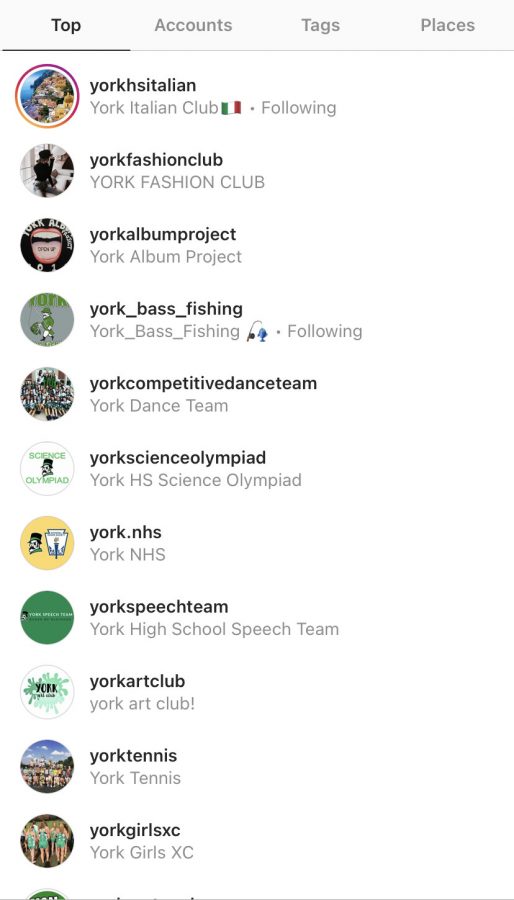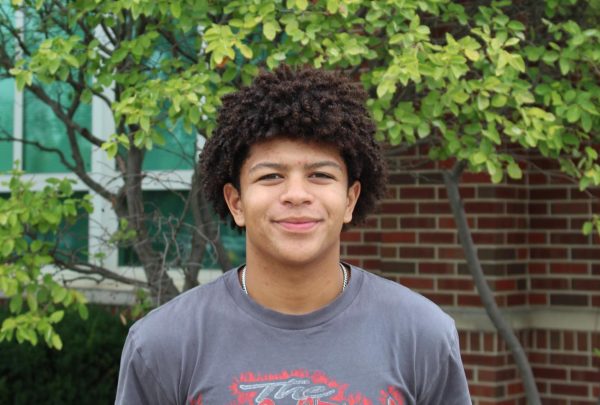The role of social media increases in student organizations
The results of an Instagram search “York” produce the pages of several York clubs and teams to follow.
November 10, 2020
Without the posters in the halls, the designated time for morning announcements or teachers shouting a date and time for an event as students shuffle out the door, getting the attention of students has become a challenge. Since school has been attended remotely since August, the role of social media grew in relaying information about student organizations to its members and in recruiting new members.
“One of the biggest challenges for us has been not having regular YTV announcements, which always seem to be the most effective way to get the word out,” Student Council sponsor and social studies teacher, Matt Moran said. “This year we’ve relied heavily on our students to advertise over social media, and we’ve continued to use thisisyork.org to post a lot of our surveys, sign-ups, advertisements, etc.”
Because of the challenges COVID-19 has presented, York organizations started relying on alternate ways to spread the word about the interesting aspects that it has to offer, especially to this year’s group of freshmen, who are at a particular disadvantage this year.
“When you’re new at something, you don’t know what you don’t know, and you go through this process of awakening,” Ashley Tucker, school counselor and Freshman Orientation Group leader said. “That is what freshman year is and I know that FOG is an acronym for freshman orientation guidance, but I think it’s funny that it’s the word fog because its like you’re in a state of fog, so I think this year it is a new experience that even our mentors couldn’t describe because they didn’t have to go through that.”
As difficult as it is informing freshmen, it is just as hard to inform freshmen mentors in the FOG program.
“The process of getting mentoring off the ground this year was a mammoth effort,” Tucker said. “It just required a lot of pivoting and pivoting and pivoting because our situation kept changing and changing, and it wasn’t anyone’s fault, it’s just the current world that we’re in. So we had to really be creative and think outside the box and hope that everyone would be open to a big change to the program.”
Typically, mentors are given a group of freshmen that meet all together at lunch. Now, mentors must reach out to their assigned freshmen individually using their phone numbers, school email, or social media. Organizations, like FOG, became more inventive with the way that they share information online, such as creating QR codes to share and scan virtually, making google sites, and frequently posting on their social media accounts.
“As far as the events that we have done this year, we’ve had to be much more focused and creative with pulling them off,” Moran said. “Our Student Council members have used social media very well this year, and that is probably the biggest factor why our Movie in the Park event on October 16th was such a success.”
Even clubs like Best Buddies, Future Diplomats of America and Art Club, to name a few, reach out to students through follow requests and stories on Instagram.
“In Italian Club, we use Instagram and Snapchat to post when a club meeting is happening and reminders,” Italian Club President and junior Maria Chornij said. “The most helpful way to communicate with club members is through social media since everyone is always on it.”
While COVID-19 disadvantaged our student organizations, they found ways to work around the communication challenges they face.
“I think when used in the right way that social media has given us more options of ways to have our connections be successful,” Tucker said.








